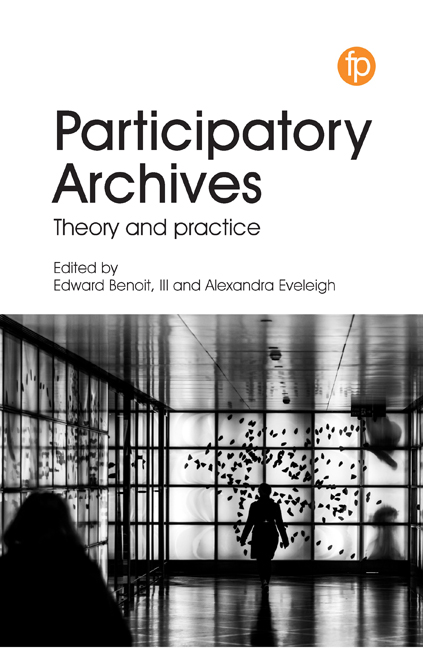Book contents
- Frontmatter
- Contents
- Figures and table
- Notes on contributors
- 1 Defining and framing participatory archives in archival science
- SECTION 1 SOCIAL TAGGING AND COMMENTING
- 2 Social tagging and commenting in participatory archives: a critical literature review
- 3 Social tagging and commenting: theoretical perspectives
- 4 Project Naming: reconnecting indigenous communities with their histories through archival photographs
- 5 (Hash)tagging with the users: participatory collection of digital social photography in museums and archives
- SECTION 2 TRANSCRIPTION
- SECTION 3 CROWDFUNDING AND OUTREACH
- SECTION 4 ALTERNATIVE AND ACTIVIST COMMUNITIES
- Notes
- Index
4 - Project Naming: reconnecting indigenous communities with their histories through archival photographs
from SECTION 1 - SOCIAL TAGGING AND COMMENTING
Published online by Cambridge University Press: 25 October 2019
- Frontmatter
- Contents
- Figures and table
- Notes on contributors
- 1 Defining and framing participatory archives in archival science
- SECTION 1 SOCIAL TAGGING AND COMMENTING
- 2 Social tagging and commenting in participatory archives: a critical literature review
- 3 Social tagging and commenting: theoretical perspectives
- 4 Project Naming: reconnecting indigenous communities with their histories through archival photographs
- 5 (Hash)tagging with the users: participatory collection of digital social photography in museums and archives
- SECTION 2 TRANSCRIPTION
- SECTION 3 CROWDFUNDING AND OUTREACH
- SECTION 4 ALTERNATIVE AND ACTIVIST COMMUNITIES
- Notes
- Index
Summary
Inuit are storytellers by nature, and everything we hear we like to tell other people … just hearing these stories helps us to keep going. So the stories that I heard from these elders, I'm going to be telling them to my children, my grandchildren, my nieces and nephews, and so on. And I think having these photographs gives the story a picture too, so that we can just look at the picture and remember the story that was told about that picture. You learn your family tree through pictures.
Paula Ikuutaq Rumbolt, from Qamani'tuaq, NunavutA special thanks to Elder Piita Irniq, Murray Angus and Morley Hanson for conceptualising Project Naming, and to the photo archivists who saw the need and supported this initiative, and to my colleague William Benoit for his input and feedback.
Introduction
I started working at the National Archives of Canada, now Library and Archives Canada, in June 2003. One of my first assignments was Project Naming, which began the year before my arrival. The project is a photographic identification and community engagement initiative that began with the digitisation of approximately 500 photographs of Nunavummiut taken in the late 1940s and early 1950s by photographer Richard Harrington. With a few exceptions, the names of Inuit were never recorded in this collection of photographs.
In early 2000, Inuit students from Nunavut Sivuniksavut (NS) in Ottawa took digital images to four communities in Nunavut, to share with elders for identification. That June, Library and Archives Canada received the names gathered through these intergenerational conversations. The results were an overwhelming success as three-quarters of the individuals depicted in the photographs now had identities. In addition to the names, the elders shared other genealogical information and described the activities, clothing and geographical places captured in the images.
Since its modest beginnings, Project Naming developed into a nationally and internationally renowned community engagement initiative. While I recognised its importance in 2003, I never imagined the impact it would have on indigenous communities involved or its influence on the archival community.
The work of Project Naming is part journey and part process. It is about communities and reconciliation – individually and collectively.
- Type
- Chapter
- Information
- Participatory Archives , pp. 45 - 58Publisher: FacetPrint publication year: 2019
- 1
- Cited by



